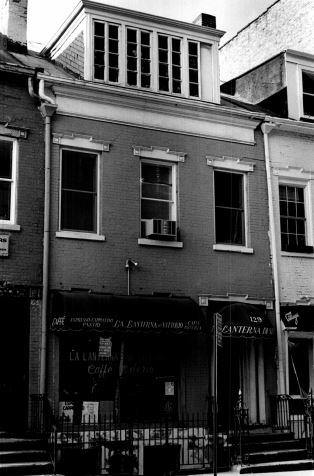127, 129, and 131 MacDougal Street: Architecture, Artists, African Americans, and “Alternative Lifestyles”
On June 8th, 2004, 127, 129, and 131 MacDougal Street, three 1829 Federal Style houses, were landmarked — the first three of thirteen Village Preservation and the NY Landmarks Conservancy jointly proposed and campaigned for landmark designation. On December 17, 2013, they were landmarked again as part of the South Village Historic District following a decade of advocacy by Village Preservation. While all three retain significant elements of early 19th-century architecture, they also contain elements reflecting Greenwich Village’s centrality to the history of immigrants, artists, African Americans, and the LGBTQ+ community.

According to the landmark designation report for the structures, as Washington Square Park was being developed, large and handsome houses were built on east-west streets south of the Square, and more modest dwellings for the working class were constructed on many of the north-south streets, such as these. This block of MacDougal Street was developed with houses more modest than those on the Square. From when they were constructed through the later part of the 19th century, this block attracted and housed the merchant and professional class.
The four houses at 125, 127, 129, and 131 MacDougal Street were speculatively built in 1828-29 by downtown hat merchant Alonzo Alwyn Alvord (June 9, 1839 — May 24, 1875) as the area around Washington Square converted from a potter’s field to an upscale residential neighborhood. All four were built in the Federal Style, as was common at the time. The Federal Style, and these homes, were characterized by their 2.5 story height, Flemish bond brickwork, low stoop with wrought-ironwork, entrance with Ionic columns, entablature and transom, molded lintels with end blocks, peaked roof, molded cornice, and pedimented double dormers.

In 1867, 125 MacDougal Street was significantly altered to four stories from the original 2.5, and extended to cover the full tax lot. This reflects the rapid transformation of much of this area after the Civil War into a largely working class immigrant district, with many of the rowhouses demolished and replaced with tenements, or “tenementized” like this one. That change is also likely the reason 125 was not landmarked in 2004 with its sister buildings 127, 129, and 131, which remained mostly unaltered on the exterior, though all eventually transformed from single family houses to apartments.
From 1833-1839, 127 MacDougal Street was owned by Anthony Lewis DeRose (August 17, 1803 – April 16, 1836) and his wife Susan DeRose. He was a portrait, historical, and miniature painter who exhibited at the American Academy and National Academy. His portrait of Davy Crockett (August 17, 1786 – March 6, 1836) is owned by The New-York Historical Society.

| By the end of the Civil War, the heydey of the neighborhood as one of New York’s most desirable had ended and as the neighborhood became even less fashionable in the late 19th century, all three buildings were transformed into lodging homes for the working class. Census records indicate several African American residents lived at the properties at that time, as by the mid-to-late 19th century, Greenwich Village was home to the “Little Africa” neighborhood, the largest African American community in New York and the center of African American life in the city. In the 1910s, this block of MacDougal Street became a cultural and social center of bohemian Greenwich Village. Next door at 133 MacDougal Street, the Provincetown Playhouse opened in 1916. |

| The ground floor of 127 MacDougal was in commercial use by 1920. Alterations to the house included the creation of a roof “studio dormer” by linking its two dormers (pre-1920) and lowering the first-story windows as storefront windows (c. 1950s). The addition of these “artists’ studio” windows and spaces reflected the transformation of Greenwich Village at the time as a center of artistic life in New York. 129 MacDougal was also in commercial use by 1920 when noted Hungarian-born portrait photographer Nickolas Muray had his studio here. Alterations to the house included the creation of a roof “studio dormer” by linking its two dormers (c. 1933-38). Later it was briefly Eve Addams’ Tearoom, an after-theater club run by Eva Kotchever, a Polish Jewish lesbian. She was deported after being convicted of obscenity for her book of lesbian-themed short stories and was killed by the Nazis. |

131 MacDougal’s two dormers were also linked to create a roof “studio dormer” (c. 1950s) and the lowering and joining of the first-story windows as a commercial storefront (c. 1950s and post-1979).

Since then, the ground floor units housed numerous commercial tenants. 127-129 have been the home of the popular restaurant La Lanterna di Vittorio since 1977.

Click here to read more about Village Preservation’s efforts to protect Federal Style houses.
